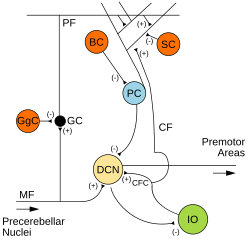
Back Núcleo olivar inferior Spanish Beheko oliba nukleo Basque هسته زیتونی زیرین Persian Nucleo olivare inferiore Italian 下オリーブ核 Japanese 아래올리브핵 Korean Núcleo olivar inferior Portuguese 下橄榄核 Chinese
| Inferior olivary nucleus | |
|---|---|
 Microcircuitry of the cerebellum. Excitatory synapses are denoted by (+) and inhibitory synapses by (-). MF: Mossy fiber. DCN: Deep cerebellar nuclei. IO: Inferior olive. CF: Climbing fiber. CFC: Climbing fiber collateral. GC: Granule cell. PF: Parallel fiber. PC: Purkinje cell. GgC: Golgi cell. SC: Stellate cell. BC: Basket cell. | |
 Transverse section of medulla oblongata below the middle of the olive. (Inferior olivary nucleus labeled at center right.) | |
| Details | |
| Part of | Olivary body |
| Identifiers | |
| Latin | complexus olivaris inferior, nuclei olivares inferiores |
| MeSH | D000095746 |
| NeuroNames | 748 |
| TA98 | A14.1.04.008 A14.1.04.219 |
| TA2 | 5988, 6021 |
| FMA | 72243 |
| Anatomical terms of neuroanatomy | |
The inferior olivary nucleus (ION) is a structure found in the medulla oblongata underneath the superior olivary nucleus.[1] In vertebrates, the ION is known to coordinate signals from the spinal cord to the cerebellum to regulate motor coordination and learning.[2] These connections have been shown to be tightly associated, as degeneration of either the cerebellum or the ION results in degeneration of the other.[3][4]
Neurons of the ION are glutamatergic and receive inhibitory input via GABA receptors.[1] There are two distinct GABAα receptor populations that are spatially organized within each neuron present in the ION. The GABAα receptor make-up varies based on where the receptor localizes on the ION neuron.[5] The reason for this spatial distribution is unknown. It has been proposed that the distinct populations of GABAα receptors allows for fine-tuned regulation within the ION.[5]
- ^ a b Gado, Thomas A. Woolsey; Joseph Hanaway; Mokhtar H. (2003). The brain atlas a visual guide to the human central nervous system (2nd ed.). Hoboken, NJ: Wiley. p. 206. ISBN 0-471-43058-7.
- ^ Schweighofer N, Lang EJ, Kawato M. Role of the olivo-cerebellar complex in motor learning and control. Frontiers in Neural Circuits. 2013;7:94. doi:10.3389/fncir.2013.00094.
- ^ Brodal A., Kawamura K. (1980). The Inferior Olive. Notes on its Comparative Anatomy, Morphology, and Cytology. In: Olivocerebellar Projection. Advances in Anatomy Embryology and Cell Biology, vol 6. Berlin, Heidelberg: Springer. ISBN 978-3-642-67775-5.
- ^ Gatlin JL, Wineman R, Schlakman B, Buciuc R, Khan M. Hypertrophic Olivary Degeneration After Resection of a Pontine Cavernous Malformation: A Case Report. Journal of Radiology Case Reports. 2011;5(3):24-29. doi:10.3941/jrcr.v5i3.603.
- ^ a b Alastair M. Hosie, Megan E. Wilkins, Helena M. A. da Silva & Trevor G. Smart. Endogenous neurosteroids regulate GABAA receptors through two discrete transmembrane sites. Nature 444, 486-489. doi:10.1038/nature05324